By John R. “Buck” Surdu
Introduction:
How do you run a “wargame” with only a little bit of war? I’m a fan of the Dr. Who series, particularly the Jon Pertwee era. That’s a little unusual on this side of the pond, as most of us grew up on Tom Baker. A friend of mine in the UK I meant on business turned me on to Pertwee, and now I’m hooked. I wanted to put together an interesting scenario that captured the flavor of the series. The shows typically don’t involve a great deal of shoot-em-up, but I have not had much luck trying to run mystery solving pulp games at conventions.
One of the members of our group is a huge Dr. Who fan. He’s one of those guys who can tell you what brand socks one of the companions was wearing in episode four of some story arc. He hit upon the notion that you have to swap the foreground and background action.
In a Doctor Who story arc, any shooting is background action. There may be some shooting or other violence between UNIT and the Sontarans or between the Daleks and the natives of some remote jungle planet. The foreground action, however, involves the Doctor trying to solve a mystery or invent some new device to defeat the alien plot. By swapping the foreground and background action, most of the players have something to do that is akin to a normal skirmish wargame, but there is enough background puzzle solving to capture the feel of the genre.
At the recent Origins game fair in Columbus, Ohio, I tested this concept in a Doctor Who scenario very loosely based on the Pertwee story, The Green Death. Warning: Doctor Who purists will surely be offended by my anachronistic mingling of Doctor Who elements. I started with the Third Doctor, who was the doctor in the original Green Death series. Since I cannot stand Jo Grant, who was the companion in that series, I decided to use Elizabeth Shaw instead. She was a Third Doctor companion; she was a scientist; and she had tremendous legs. I wanted another character to help invent things, so I added Romana (the Mary Tamm incarnation, a Fourth Doctor companion, but I love the friction between her and The Doctor). I set my scenario in WWII, where Brigadier Lethbridge-Stewart is Lieutenant Lethbridge-Stewart of the Home Guard, along with Sergeant Benton and Sergeant Osgood. Finally, I added K-9, who does not appear in the series until the Fourth Doctor.
While I ran this game as Doctor Who by G.A.S.L.I.G.H.T., I took inspiration from the Doctor Who Miniatures Game 2nd edition by Graeme Dawson. As that game was focused on Doctor Who, Dawson had thought through how to depict the attributes of the various characters. While I have a bias toward G.A.S.L.I.G.H.T. and its flexibility for Victorian science fiction, Pulp, and other genres, the Doctor Who Miniatures Game has a lot to offer.
Scenario Overview:
The scenario runs in two phases, with the objectives of some of the factions changing during the transition from phase one to phase two. At the beginning of the game, the players are only informed of their phase one objectives. In phase one, the security guards for global chemicals are anxious to ensure that no one sees the worm and tries to shut them down. The Home Guard, on the other hand, having seen evidence that the worms are dangerous, are trying to find and kill them to protect the local citizenry. Meanwhile The Doctor, Romana, and Liz are trying to stop the Home Guard from killing this new life form. In this phase, there is very little shooting. The Home Guard may shoot at the worms, but not at the security guards. The security guards, likewise, should avoid firing on the soldiers during wartime. If they do, however, the Home Guard may return fire. During phase one, the first of The Doctor, Romana, or K-9 to get near a worm will sense that the worms poop jethric.
In this game, players may want to Scuffle without killing each other. They should declare before rolling whether they are trying to kill or just knock out their opponent. If they are trying merely to knock out their opponent, the defeated figure is lain face up on the table to indicate that it is still alive. Dead figures are typically laid face down.
There is a group of 10 civilian noncombatants protesting the pollution being created by Global Chemicals. They are just outside the gate to the Global Chemicals compound. The security guards can lure or drag them into the compound. Any humans inside the compound can be hypnotized and turned into “zombies” by the BOSS (Biomorphic Orgnisational System Supervisor) computer. This computer has hypnotized Stevens and the rest of the Global Chemicals people. Once hypnotized, they are under the control of the Stevens or Elgin player.
Phase two begins when the Sontarans and the Daleks land at the sites indicated on the map. At that time, the players are informed of their phase two objectives. At this point, the shooting is likely to be widespread. The Sontarns and Daleks are quite difficult for the Earthmen to defeat; however, The Doctor, Romana, and Liz may attempt invent items that improve their chances. In addition, the Sontars and Daleks may not become allies and so will undoubtedly begin shooting each other at some point.
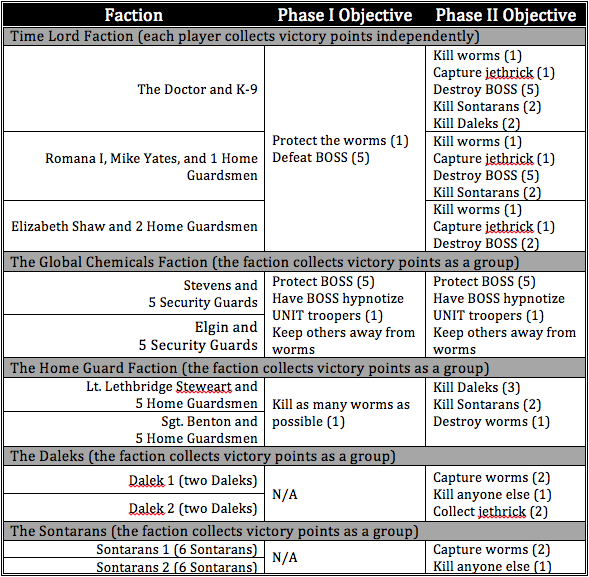
The above chart identifies the victory conditions for each player/faction. The numbers in parentheses after each object are the number of points for each instance. Even if a player’s or faction’s objective changes between phase one and phase two, the player keeps those points. This may mean that The Doctor receives a point for rescuing a worm in phase one and then gains a point in phase two for killing it.
Map:
This map shows the basic layout of the scenario as well as the starting and entry points of the various player elements. When phase two begins, place a Sontaran drop ship on each “S” on the map. Place a Dalek space ship near the two “D”’s on the map. Place three Sontarans near each drop ship. Place all four Daleks next to their space ship.

The Worms:
There are sixteen worms in the scenario. The first nine are placed on the table where the X’s are shown on the map. Near each worm should be a marker indicating jethric. I use green, plastic gems from a hobby store. Every turn after that, the game master should add another worm around the TARDIS, from the well or from the cave until all the worms have been placed. Any worms on the table will move one inch toward a human.
Worms may not be picked up or moved without first being “subdued.” This is done through successful melee. Once subdued, worms remain subdued as long as they remain in contact with a figure. If for some reason they are no longer in contact with another figure for two turns, on the second turn they are no longer subdued. Subdued worms may not move or attack.
Non-subdued worms that are within an inch of a figure other than a Dalek may leap at that figure and melee with it. If the worm successfully melees with a non-Dalek figure, roll a d10 (with the zero being zero, not ten) and place it next to that figure. Each time that figure acts, decrement the number on the d10 by 1. Until the die gets to zero, the figure may perform actions normally. When the die gets to zero, the figure dies.
If The Doctor or Romana takes a worm into the TARDIS, it is permanently subdued. If a Sontaran or Dalek takes a worm into their space ship, the worm is also permanently subdued.
Rules:
I used G.A.S.L.I.G.H.T. (Glorious Adventures in Science Loosely Involving Generally Historical Times). These rules were originally written for Victorian Science Fiction. A later supplement, To Be Continued… by G.A.S.L.I.G.H.T., added Pulp rules. The basic rules as well as the three supplements were combined into a single volume, The G.A.S.L.I.G.H.T. Compendium, in 2011. We’ve used these rules successfully for games from ancient Rome to World War II. As the rules were written in such a way that players could mix seamlessly elements from the basic rules and supplements, it is easy to customize your G.A.S.L.I.G.H.T. experience. Running a Doctor Who game with G.A.S.L.I.G.H.T. required only a slight modification to the rules for inventing.
In G.A.S.L.I.G.H.T., figures can be Main Characters or Extras. Main Characters have three attributes: Shoot (for shooting or throwing things), Scuffle (for hand-to-hand combat), and Save (for negating bad stuff). Extras do not have a Save number, so tend to die rather easily. Because there were so few figures in this scenario, I chose to give even the Extras small Save numbers, in accordance with the pulp rules for G.A.S.L.I.G.H.T. The Sontaran Extras had high Save numbers to account for their battle armor.
Inventing:
The G.A.S.L.I.G.H.T. rules include an optional attribute for Main Characters, called Science. Because G.A.S.L.I.G.H.T. is a skirmish game, inventing is meant to happen between games. Since the background action of the scenario involves the two Time Lords, The Doctor and Romana, and Liz trying to invent things, I wanted invention to occur during the game. Since I did not want invention to occur too early in the scenario, I handicapped invention.
The Doctor, Romana, and Liz had Science attributes of 12, 14, and 10, respectively. (Romana graduated with higher marks from the Time Lord academy than The Doctor.) For each of the “inventors,” they had an “Science roll modifier” track. Each box on this track had an associated modifier to the Science roll. The number in the box is added to the die roll as the character tries to roll a modified number lower than his or her Science number. After a Science roll, cross off a box. The next attempt will use the modifier in the next box. The early numbers on this track are high enough that a successful Science roll is impossible, but after several attempts it becomes possible.
Here are the Science roll modifier tracks for the three inventor characters:
- The Doctor: +18, +17, +16, +15, +14, +13, +12, +10, +8, +6, +4, +2, and +0 afterward.
- Romana: +18, +17, +16, +15, +14, +13, +12, +11, +10, +9, +8, +7, +6, +5, +4, +3, and +0 afterward.
- Liz: +15, +14, +13, +12, +11, +10, +9, +8, +7, +6, +5, +4, +3, +2, +1, and +0 afterward.
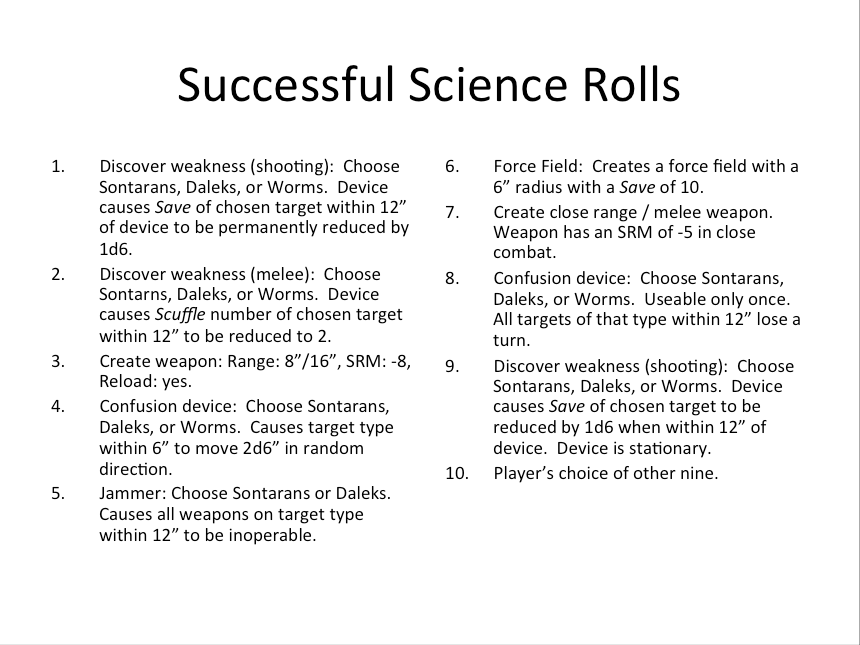
Before the game begins, the game master should place five technology markers on the table. One is placed in each of the three buildings, and two are placed near the cave entrance. Inventors may collect one or more of these technology markers. As long as the inventor possesses the technology marker, each marker accrues a -2 modifier to the number rolled when attempting a Science roll.
Each inventor may only invent one item per game. Upon a successful Science roll, the player rolls a d10 on the Successful Science Rolls chart. Note that many of the inventions say “Choose Sontarans, Daleks, or Worms.” When the die roll is made on the Successful Science Rolls chart, the player must decide which of these three life forms the invention will affect. This decision cannot be changed once the choice is made.
Victory Points:
The game ends when all the Sontarans and Daleks are dead or have gotten back in their ships and blasted back into space. Add up all the victory points accrued by each faction. Note that some players add up points individually while others collect points as a faction. The player or faction with the most points at the end of the scenario wins.
Figures:
Dr. Who figures are available from a variety of sources. I used the Third Doctor figure and the Dalek figures from the now-defunct FASA line, but figures are also available from Blacktree. My Home Guard figures are from Foundry. The Sontarans are from the UK children’s weekly magazine “Doctor Who Adventures.”
How the Game Played:
I play tested the scenario with our club before taking it to the convention. While the games played out quite differently, both were quite enjoyable. In phase one there was enough foreground action with the Home Guard trying to get past the security guards to get to the worms. In phase two there was plenty of action between the Daleks, Sontarans, Home Guard, and security guards to keep everyone interested. In the meanwhile the inventors were busy collecting technology points and rolling against their Science numbers to invent devices.
In the play test, the player controlling The Doctor used the TARDIS to get next to the Dalek space ship. While the Daleks were busy collecting worms and jethric, he ran inside, stunned the single Dalek inside with his sonic screwdriver, grabbed a piece of jetrhic, set the ship to self destruct (a spontaneous good idea by the player that I allowed as game master), and run. He rolled a d4, resulting in four turns until the ship would blow up. In the meantime, the stunned Dalek woke up and attempted to turn off the self-destruct mechanism. Rolling a 20 (which is always bad in G.A.S.L.I.G.H.T.), instead of disabling the self-destruct, the ship exploded immediately.
In the convention game, the player controlling Lethbridge-Stewart was particularly humorous in the way he role played his character. Remember the scenario takes place in 1940. It was funny to hear Lethbridge-Stewart refer to the Sontarans as “Jerry paratroopers.”
Conclusion:
I’m no pacifist, but I have long wanted to run games that were more than a traditional shoot-em-up. The notion of swapping the foreground and background action was quite successful. I’ve tried many times to run games with puzzle solving, inventing, or both. Though the intent of the scenario was something other than combat, the games always devolved into shooting. In many cases, players would quickly determine that if they killed all the other players’ figures that they could collect the treasure or clues at their leisure. This scenario, on the other hand, really felt like a Doctor Who episode.
Download the Player Special Rule and Objective Cards
Download the Character Record Cards


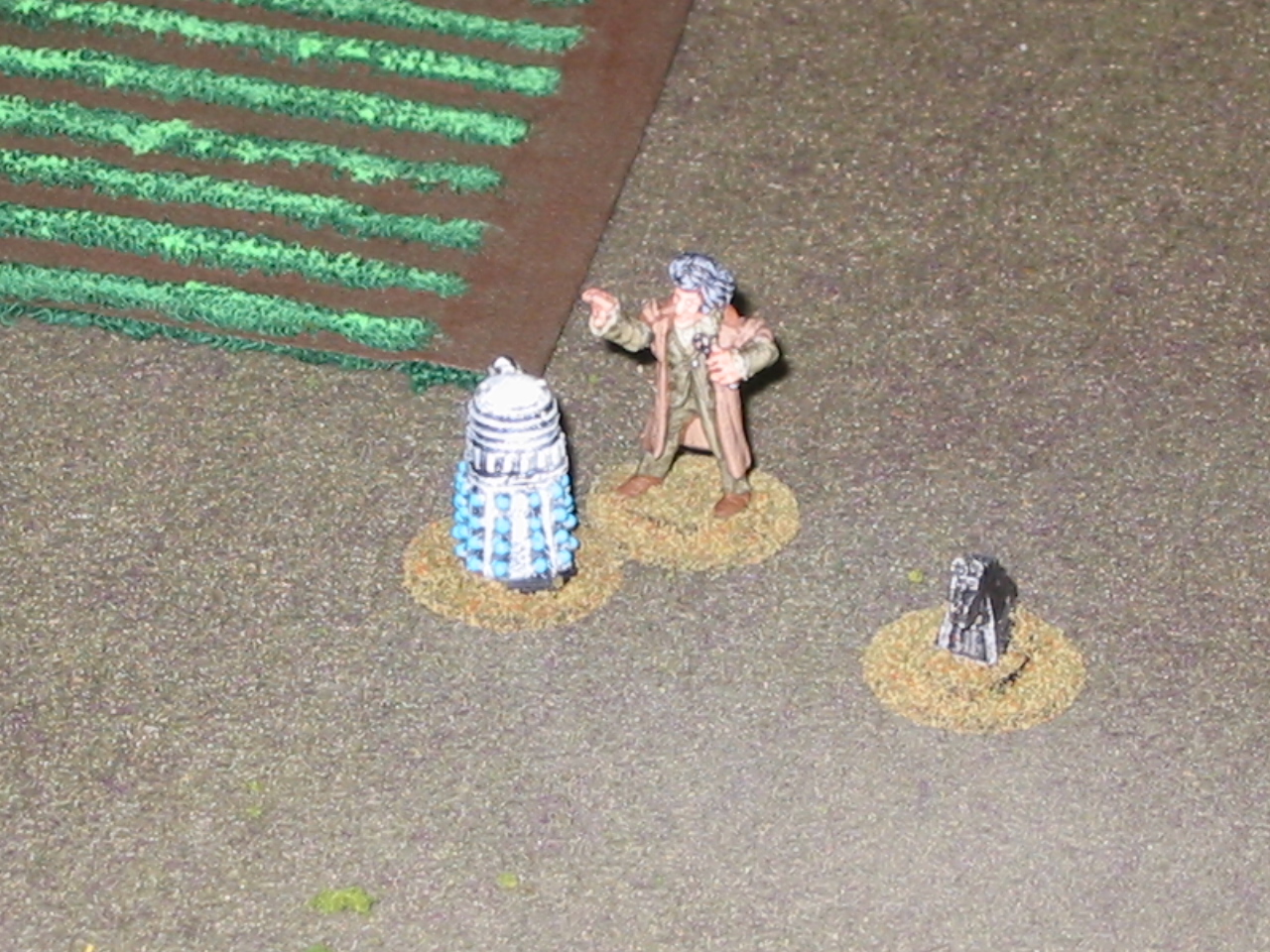
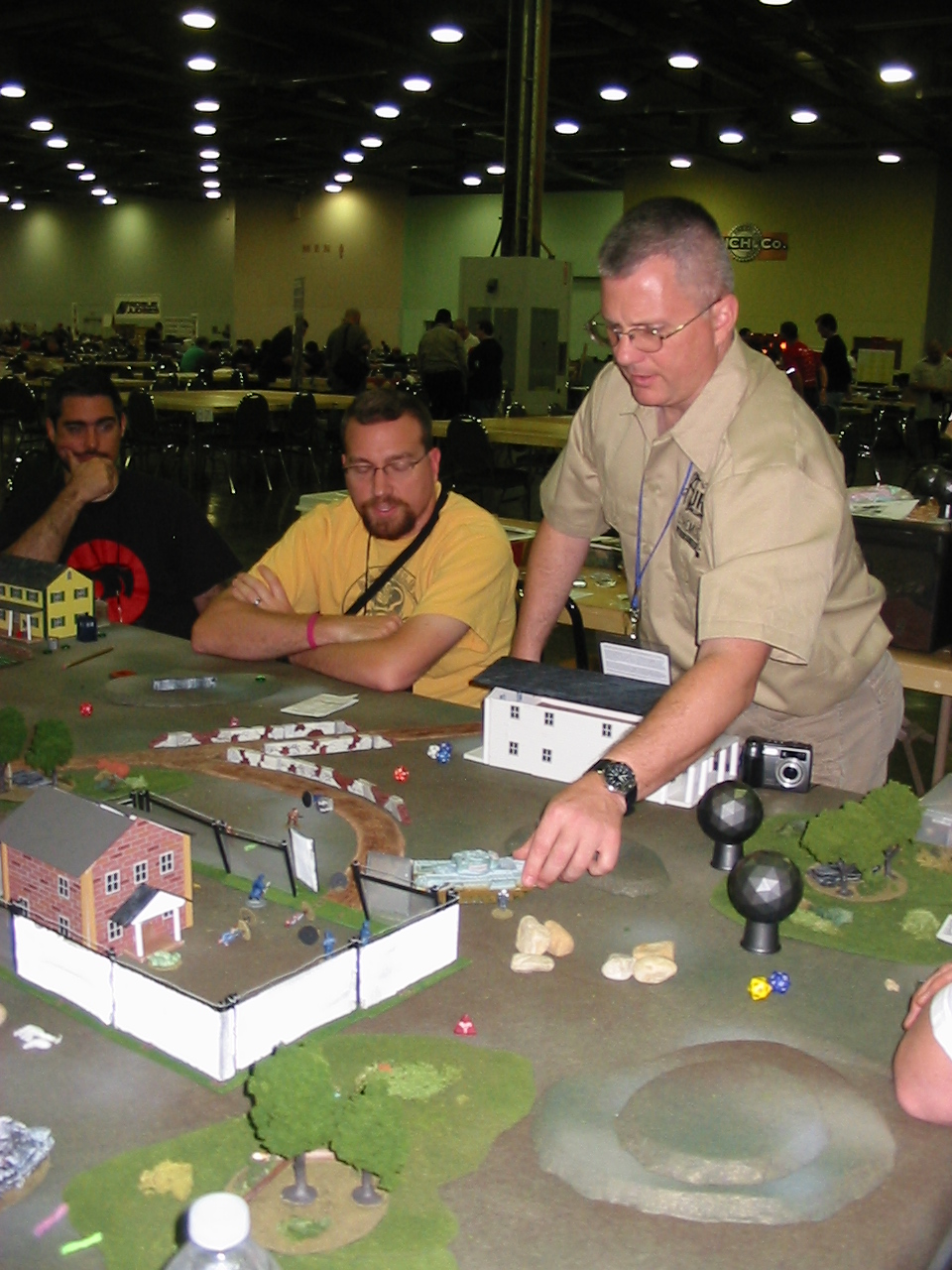
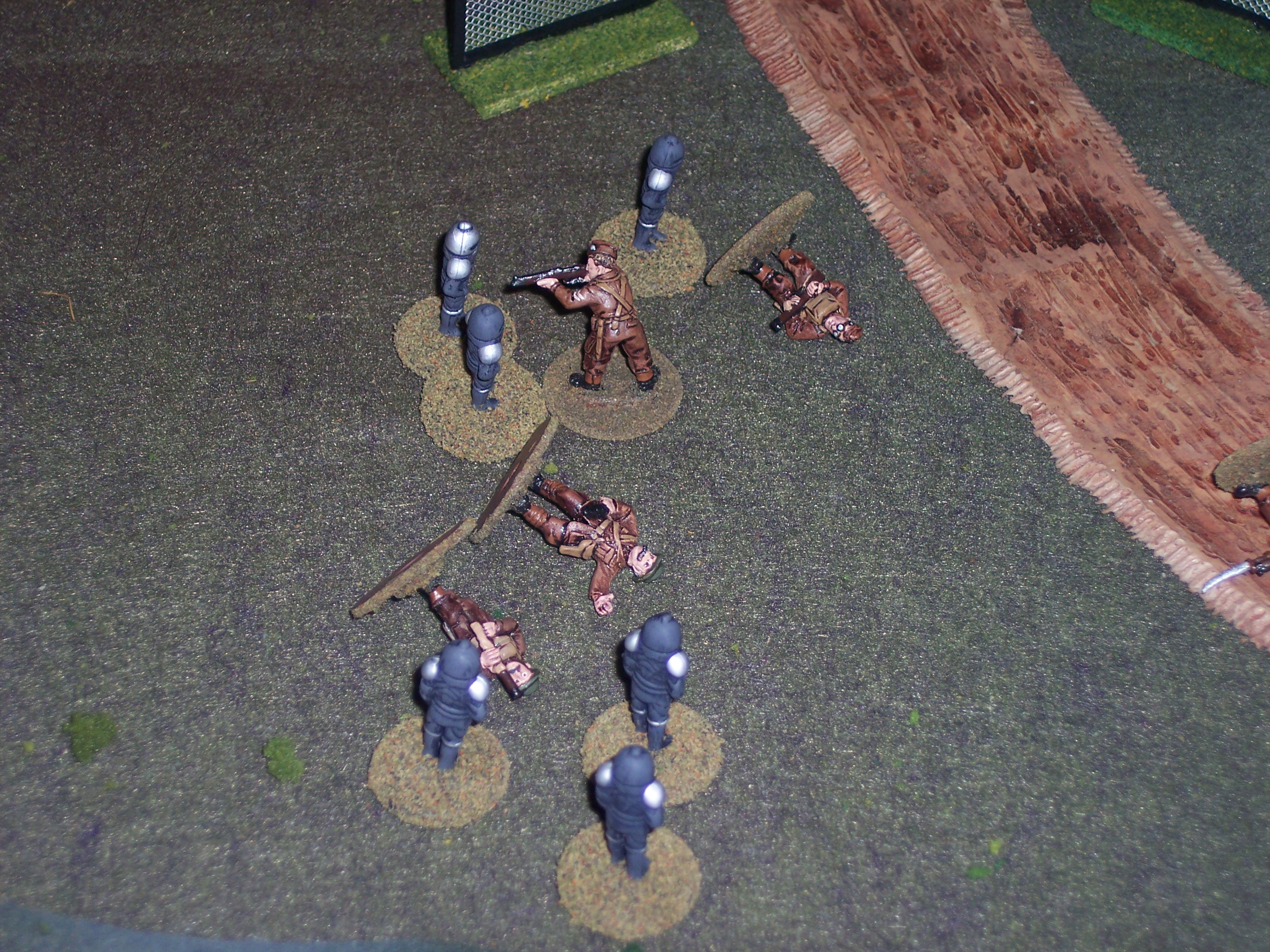
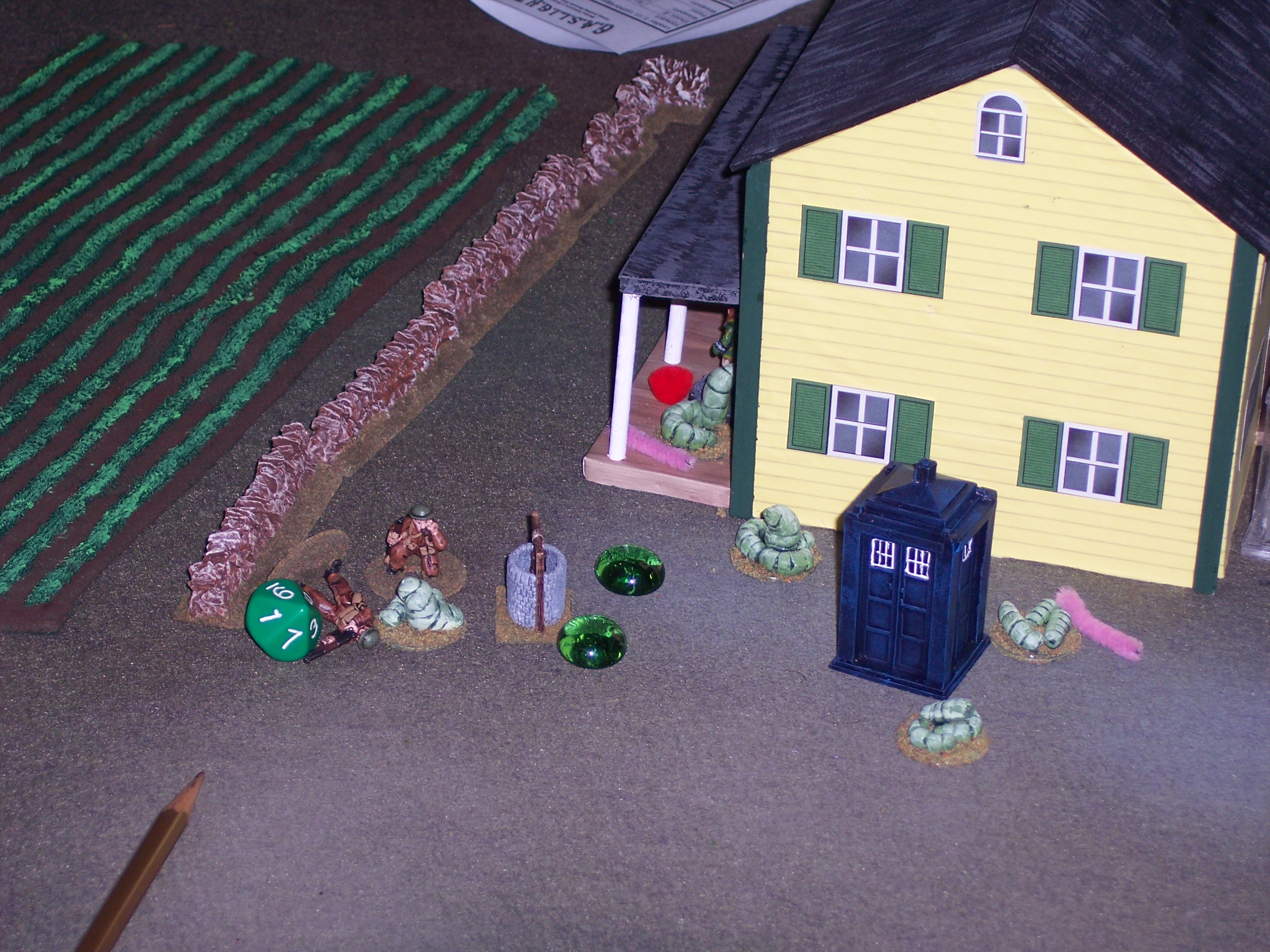
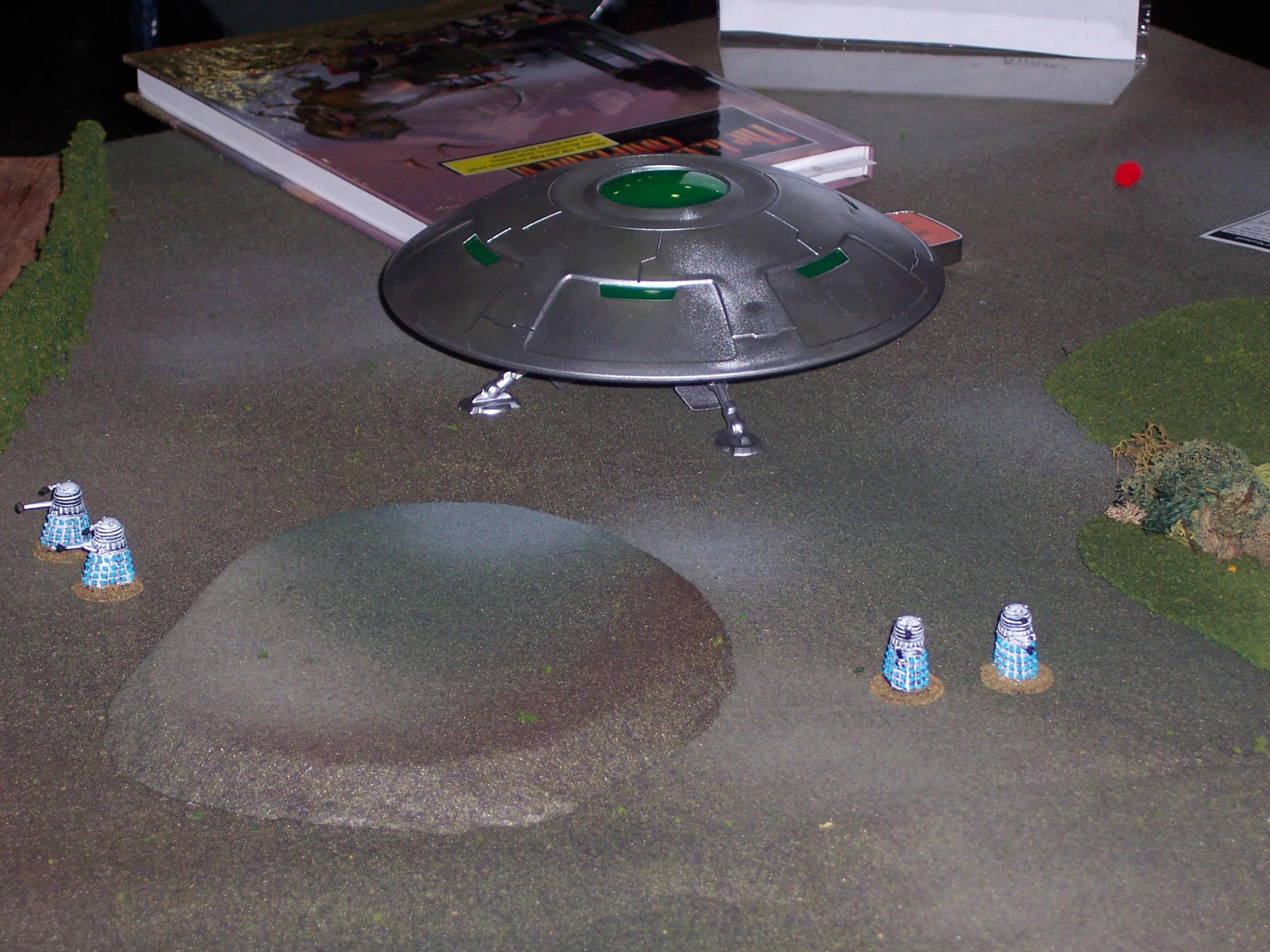
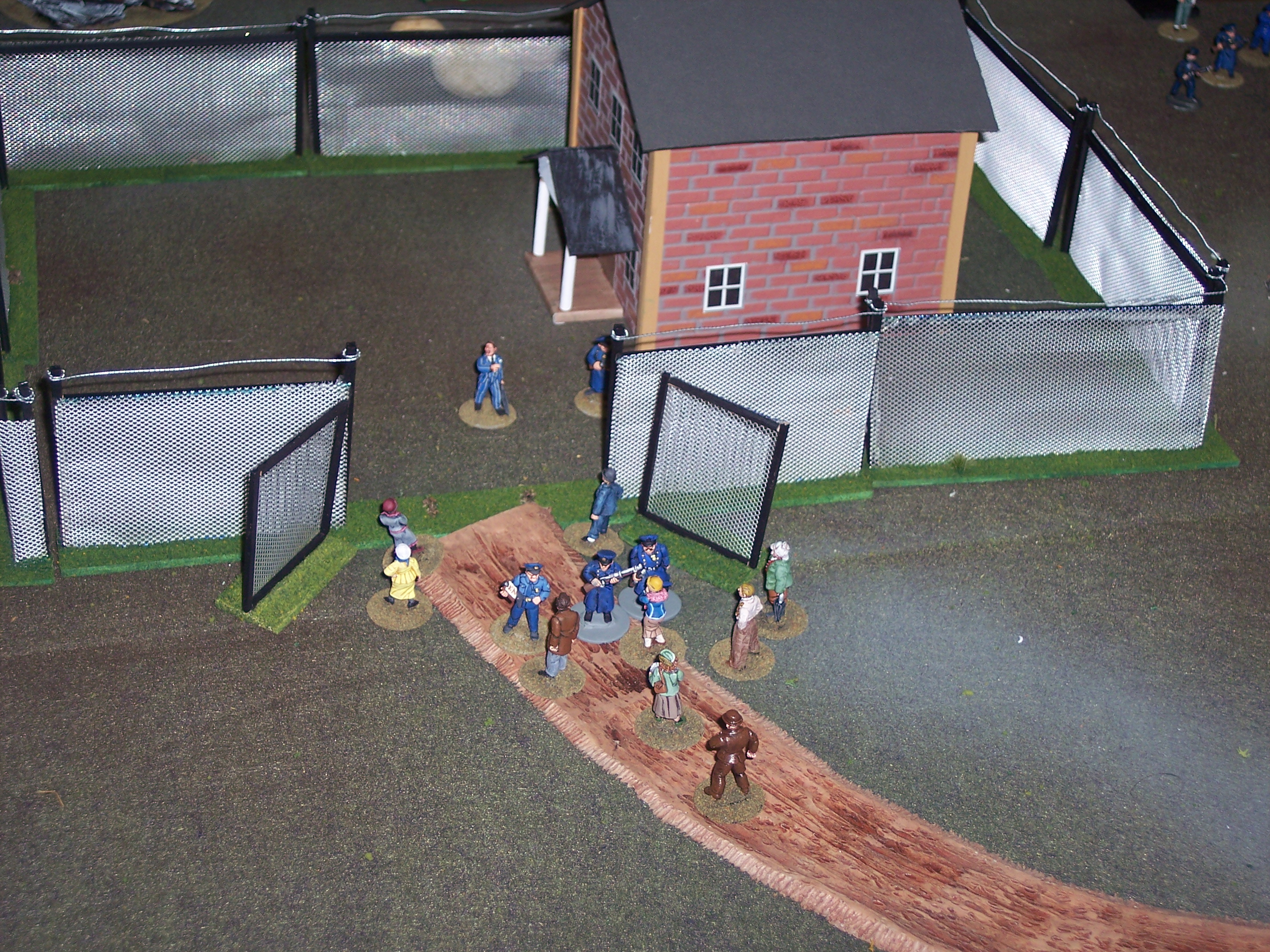



3 responses to “Doctor Who by G.A.S.L.I.G.H.T.”
[…] An article I wrote on running a Dr. Who-based GASLIGHT game was recently published on Cigar Box Battle: http://www.cigarboxbattle.com/doctor-who-by-g-a-s-l-i-g-h-t/ […]
On Jul 6, 2013, at 11:36 AM, Info Account wrote:
Hey Buck, we had a reader with a few questions about your recently posted article! If you can spare the time to help this guy out that would be great! Message is below:
Chris
—————-
Reader: Hi, I really enjoyed your article about using your rules for Doctor Who games.
Reader: I didn’t quite understand how it would all work though.
Reader: In the 1st phase, is it basically the chemical workers & time lord factions doing non-lethal subduing fights with the home guard?
Buck: Yes, in the first phase, there were a lot of non-lethal attacks as players tried to accomplish their missions. I ran it twice. In both convention games, the Home Guardsmen were aggressive in trying to get to into the Global Chemicals compound and the mine entrance. The guards are trying to stop them — and so are the inventors.
Buck: Also, the player for Global Chemicals is trying to subdue the protestors and drag them into the camp to be hypnotized.
Reader: & it seems like all the time lord factions will be doing is running around to pick up the technology bonus pieces, & then staying out of the way making 1 science die roll/turn.
Buck: Yes, they will be looking for technology and inventing, but they also need to be trying to defeat BOSS. That is worth a lot of victory points in phase I. In one running of the game, Romana made it into the compound during phase I.
Reader: That doesn’t sound too fun for the time lords, or am I missing something?
Buck: Watch the victory points. every time they can do something that stops the Home Guard from killing a worm, they get a point. Also, defeating BOSS is worth a lot of points. While the inventors need to invent things in phase II, they can also rack up points in phase I doing other things than looking for technology.
Reader: At the beginning of the game, do you assign dalek & sontaran players & have them just wait during phase 1, & then have the chemical worker player wait through the 2nd phase of the game? Or do you try to have the same players play both the workers, & then the daleks & sontarans.
Buck: The Global Chemical workers still have victory points they can accrue in Phase II. Not only do they need to protect BOSS, but they get points for hypnotizing Home Guardsmen. They also may find themselves in contact with Sontarans and Daleks to prevent them from getting their victory points.
Buck: I assigned the Sontarns and Daleks to one player each with the idea that if another player had lost all his forces, that player could take one of the Dalek or Sontaran factions. The space invaders are easier to play, so I assigned these factions to less experienced players. In Phase I, the players can watch what the others are doing and gain some comfort with the rules.
Buck: Note that I don’t specify when the space invaders land. This is a GM call. You need to make sure that the players have enough time to accomplish some of their Phase I objectives but not too long.
Looks like an interesting game. What size was the board, / mat 5′ x 5′?